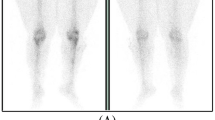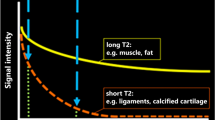Abstract
Purpose
To establish the sensitivity and specificity of cross-sectional scintigraphy [single photon emission computed tomography (SPECT)] combined with computed X-ray tomography (CT) in the detection of sacroiliac joint (SIJ) mechanical dysfunction and evaluate reproducibility of reporting.
Methods
Patients with pelvic girdle pain either on the basis of peri-partum SIJ dysfunction or trauma were included. These patients were imaged with bone scintigraphy with hybrid imaging with SPECT/CT.
Results
The study group comprised 100 patients (72 females, 28 males). Trauma accounted for 52 % and the remainder were patients with peri-partum pain. Average age was 43 years and average length of history was >2 years. The major finding was increased uptake in the upper SIJ and posterior soft-tissues/ligaments. Hybrid imaging had a sensitivity of 95 % and specificity of 99 %. Positive predictive value was 99 % and negative predictive value 94 %. Power of the test was 1.0. Reproducibility of the test was good with kappa values of 0.85.
Conclusion
Hybrid imaging with SPECT/CT reproducibly demonstrates metabolic alterations around the SIJ in patients with SIJ dysfunction, which we have termed SIJ incompetence. The condition is more common than previously recognised and frequently occurs after trauma, which has not been reported previously.




Similar content being viewed by others
References
Goldthwaite JE, Osgood RB (1905) A consideration of the pelvic articulation from an anatomical, pathological, and clinical standpoint. Boston Med Surg J 152:593–601
Mixter WJ, Barr JS (1934) Rupture of the intervertebral disc with involvement of the spinal canal. N Engl J Med 11:210–215
Dreyfuss P, Michalsen M, Pauza K (1996) The value of medical history and physical examination in diagnosin SIJ pain. Spine 21:2594–2602
Vleeming A, Albert H, Östgaard HC, Sturesson B, Stuge B (2008) European guidelines for the diagnosis and treatment of pelvic girdle pain. Eur Spine J 17(6):794–819
Albert H, Godskesen M, Westergaard J (2002) Incidence of four syndromes of pregnancy-related pelvic joint pain. Spine 27:2831–2834
Larsen EC, Wilken-Jensen C, Hansen A, Jensen DV, Johansen S, Minck H, Wormsley M, Davidsen M, Hansen TM (1999) Symptom-giving pelvic girdle relaxation in pregnancy. I: prevalence and risk factors. Acta Obstetricia Gynecolog Scand 78:105–110
Ostgaard HC, Andersson GBJ, Karlsson K (1991) Prevalence of back pain in pregnancy. Spine 16:549–552
Maigne JY, Aivaliklis A, Pfefer F (1996) Results of sacroiliac joint double block and alue of sacroiliac pain provocation tests in 54 patients with low back pain. Spine 21:1889–1892
Schwarzer AC, Aprill CD, Bogduk N (1995) The sacroiliac joint in chronic low back pain. Spine 20:31–37
Dreyfuss P, Dreyer SJ, Cole A, Mayo K (2004) Sacroiliac joint pain. J Am Acad Orthop Surg 12:255–265
Weksler N, Velan GJ, Semionov M, Gurevitch B, Klein M, Rozentsveig V, Rudich T (2007) The role of sacroiliac joint dysfunction in the genesis of low back pain: the obvious is not always right. Arch Orthop Trauma Surg 127:885–888
Gupta AD (2009) Sacroiliac joint pathologies in low back pain. J Back Musculoskelet Rehabil 22:91–97
Margules KR, Gall EP (1997) Sciatica-like pain arising in the sacroiliac joint. J Clin Rheumatol 3:9–15
Slipman CW, Sterenfeld EB, Chou LH, Herzog R, Vresilovic E (1996) The value of radionuclide imaging in the diagnosis of sacroiliac joint syndrome. Spine 21:2251–2254
Saenz-Navarro I, Moller I, Iagnocco A, Naredo E (2011) Ultrasound assessment of the sacroiliac joint. J Clin Ultrasound 39:93–94
Cook C, Massa L, Harm-Ermandes I, Segneri R, Adcock J, Kennedy C, Figuers C (2007) Interrater reliability and diagnostic accuracy of pelvic girdle pain. J Manip Physiol Ther 30:252–258
Hodge JC, Bessette B (1999) The incidence of sacroiliac joint disease in patients with low-back pain. Can Assoc Radiol J 50:321–323
Kokmeyer D, van der Wurff P, Aufdemkampe G, Fickenscher TCM (2002) The reliability of multitest regimens with sacroiliac pain provocation tests. J Manip Physiol Ther 25:42–48
Laslett M, Aprill CN, McDonald B, Young SB (2005) Diagnosis of sacroiliac joint pain: validity of individual provocation tests and composites of tests. Man Ther 10:207–218
Mens JMA, Vleeming A, Snijders CJ, Koes BW, Stam HJ (2002) Validity of the active straight leg raise test for measuring disease severity in patients with posterior pelvic pain after pregnancy. Spine 27(2):196–200
Ostgaard HC, Zetherstrom G, Roos-Hansson E (1994) The posterior pelvic pain provocation test in pregnant women. Eur Spine J 3:258–260
Robinson HS, Brox JI, Robinson R, Bjelland E, Solem S, Telje T (2007) The reliability of selected motion—and pain provocation tests for the sacroiliac joint. Man Ther 12:72–79
van der Wurff P, Hagmeijera R, Meyne W (2000) Clinical tests of the sacroiliac joint. A systematic methodological review. Part 1: reliability. Man Ther 5:30–36
Cusi M, Saunders J, Hungerford B, Wisbey-Roth T, Lucas P, Wilson P (2010) The use of prolotherapy in the sacro-iliac joint. Br J Sport Med 44(2):100104
Hungerford B, Gilleard W, Hodges P (2003) Evidence of altered lumbopelvic muscle recruitment in the presence of sacroiliac joint pain. Spine 28:1593–2000
Levangie PK (1999) Four clinical tests of sacroiliac joint dysfunction: the association of test results with innominate torsion among patients with and without low back pain. Phys Ther 79:1043–1057
Mens JMA, Vleeming A, Snijders CJ, Koes BW, Stam HJ (2001) Reliability and validity of the active straight leg raise test in posterior pelvic pain since pregnancy. Spine 26:1167–1171
Schneider M, Erhard R, Brach J, Tellin W, Imbarlina F, Delitto A (2008) Spinal palpation for lumbar segmental mobility and pain provocation: an interexaminer reliability study. J Manip Physiol Ther 31:465–473
Hungerford B, Gilleard W, Moran M, Emmerson C (2007) Evaluation of the ability of physical therapists to palpate intra-pelvic motion with the stork test on the support side. J Phys Ther 87:879–887
Fay M, Proschan M (2010) Wilcoxon–Mann–Whitney or t test? On assumptions for hypothesis tests and multiple interpretations of decision rules. Stat Surv 4:1–39
Hanley J, McNeil B (1983) A method of comparing the areas under receiver operating characteristic curves derived from the same cases. Radiology 148:839–843
Cohen J (1968) Weighted kappa: nominal scale agreement with provision for scaled disagreement or partial credit. Psychol Bull 70:213–220
Bruce W, Van Der Wall H, Storey G, Loneragan R, Pitsis G, Kannangara S (2004) Bone scintigraphy in acetabular labral tears. Clin Nucl Med 29:465–468
Song IH, Carrasco-Fernandez J, Rudwaleit M, Sieper J (2008) The diagnostic value of scintigraphy in assessing sacroiliitis in ankylosing spondylitis: a systematic literature research. Ann Rheum Dis 67:1535–1540
Alderink GJ (1991) The sacroiliac joint: review of anatomy, mechanics, and function. J Orthop Sports Phys Ther 13:71–84
Lee D, Lee LJ (2010) The pelvic girdle: an integration of clinical expertise and research. Churchill Livingstone Elsevier, Edinburgh
Vleeming A, Stoeckart R, Volkers ACW, Snijders CJ (1990) Relation between form and function in the sacroiliac joint. Part I: clinical anatomical aspects. Spine 15:130–132
Murakami E, Tanaka Y, Aizawa T, Ishizuka M, Kokubun S (2007) Effect of periarticular and intraarticular lidocaine injections for sacroiliac joint pain: prospective comparative study. J Orthop Sci 12:274–280
Stuge B, Holm I, Vollestad N (2006) To treat or not to treat post partum pelvic girdle pain with stabilizing exercises? Man Ther 11:337–343
Stuge B, Morkved S, Dahl HH, Vollestad N (2006) Abdominal and pelvic floor muscle function in women with and without long lasting pelvic girdle pain. Man Ther 11:287–296
Buchowski J, Kebaish K, Sinkov V, Cohen D, Sieber A, Kostuik J (2005) Functional and radiographic outcome of sacroiliac arthrodesis for the disorders of the sacroiliac joint. Spine J 5:520–528
Albert H, Godskesen M, Westergaard J (2000) Evaluation of clinical tests used in classification procedures in pregnancy-related pelvic joint pain. Eur Spine J 9(2):161–166
Hildebrand KA, Gallant-Behm CL, Kydd AS, Hart DA (2005) The basics of soft tissue healing and general factors that influence such healing. Sports Med Arthrosc Rev 13(3):136–144
Storey G, Murray I (2007) Nuclear Medicine in disorders of bones and joints. In: Ell P, Gambhir S (eds) Nuclear medicine in clinical diagnosis and treatment. Churchill Livingstone, Edinburgh
Conflict of interest
None.
Author information
Authors and Affiliations
Corresponding author
Rights and permissions
About this article
Cite this article
Cusi, M., Saunders, J., Van der Wall, H. et al. Metabolic disturbances identified by SPECT-CT in patients with a clinical diagnosis of sacroiliac joint incompetence. Eur Spine J 22, 1674–1682 (2013). https://doi.org/10.1007/s00586-013-2725-5
Received:
Revised:
Accepted:
Published:
Issue Date:
DOI: https://doi.org/10.1007/s00586-013-2725-5




